Miscellaneous Ramblings
Rolleiflex MiniDigi AF 5.0: A TLR for the Digital Age?
Charles Moore - 2008.03.24 - Tip Jar
I have to state my bias up front here: one of the more esoteric enthusiasms of my life is a passion for twin-lens reflex cameras, and I consider the venerable and near-extinct TLR to be the ne plus ultra of camera design configuration. For me, the combination of whisper-quiet operation, low vibration thanks to a minimum of moving parts, and the facility to compose one's shot on a two-dimensional groundglass screen's full negative-sized preview of the photograph (albeit reversed) rather than peering through a viewfinder or single lens reflex pentaprism made and still makes the TLR a pleasure to use.
Of course, the SLR, both in medium-format and 35mm (and more recently digital photography) has eclipsed the TLR for nearly a half-century now, but there are still a remnant of die-hard TLR fans like myself, and the TLR - particularly the legendary Rolleiflex - has acquired a sort of nostalgic mystique.
From its introduction in 1928, the Rolleiflex was the camera of choice for professionals, and for many advanced amateur photographers as well, for over 30 years.
However, the skill required to cope with the reversed focusing image, plus parallax errors in close-up work caused by the viewing and taking lenses being physically separated, and the fact that the TLR Rolleiflex did not offer interchangeable lenses, caused it to lose ground to the heavier, noisier, more expensive, much more mechanically complex, single lens reflex Hasselblads, Bronicas, Mamiyas, and ultimately Rollei's own medium format Rolleiflex SL 66 and SLX SLRs in the 1960s and 70s, not to mention the shift of 35mm from being regarded as a "minicam" format to the de facto mainstream standard.
The Rolleiflex TLR has never really gone out of production, and you can still buy one new today, albeit at an astronomical price. It's now more or less a special interest collector's item, although a highly functional one still capable of taking superb photographs.
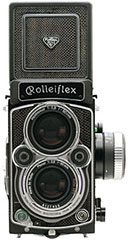 The current
line of Rolleiflex 2.8FX
and 4.0FW
(wide angle) cameras are classical twin-lens reflex cameras with
the advanced exposure-control options of a modern Rolleiflex.
State-of-the-art TTL metering and autoflash control are a combination
of tradition and progress. In all other respects, the classic Rollei's
time-tested features have been preserved, such as the folding crank
advancing the film with a rapid back-and-forth movement, at the same
time setting the shutter and stepping the frame counter without making
multiple exposures impossible.
The current
line of Rolleiflex 2.8FX
and 4.0FW
(wide angle) cameras are classical twin-lens reflex cameras with
the advanced exposure-control options of a modern Rolleiflex.
State-of-the-art TTL metering and autoflash control are a combination
of tradition and progress. In all other respects, the classic Rollei's
time-tested features have been preserved, such as the folding crank
advancing the film with a rapid back-and-forth movement, at the same
time setting the shutter and stepping the frame counter without making
multiple exposures impossible.
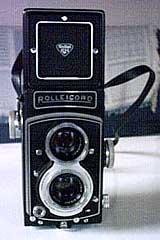 When I made
part of my living as a wedding and portrait photographer back in the
70s, my workhorse camera was a Rolleicord Vb twin-lens
reflex , the no-frills, entry-level version of the Rolleiflex. With its
razor-sharp Schneider Xenar lens and 2-1/4" square (6x6cm) negative
format, that old Rollei recorded many superb images.
When I made
part of my living as a wedding and portrait photographer back in the
70s, my workhorse camera was a Rolleicord Vb twin-lens
reflex , the no-frills, entry-level version of the Rolleiflex. With its
razor-sharp Schneider Xenar lens and 2-1/4" square (6x6cm) negative
format, that old Rollei recorded many superb images.
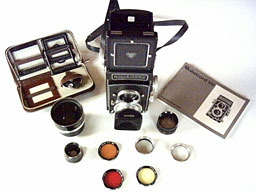 I even have an optional conversion kit that allows the big
Rollei to take 15 35mm-sized, or square "Superslide" exposures on 120
roll film rather than the standard 12, a wide angle adapter, two
diopters of parallax-corrected close-up lenses, and a few filters.
I even have an optional conversion kit that allows the big
Rollei to take 15 35mm-sized, or square "Superslide" exposures on 120
roll film rather than the standard 12, a wide angle adapter, two
diopters of parallax-corrected close-up lenses, and a few filters.
Speaking of square formats, which were necessary for the TLR's waist-level groundglass focusing screen, some folks considered them a compromise, but in actual practice the square format only required a modest amount of cropping to reach the standard 4" x 5" and 8" x 10" print formats. Taking square negatives leaves your options open for sectional enlarging to obtain horizontal or vertical pictures without determining composition right from the beginning, and with a negative area almost four times that of the 35 mm format, you have plenty of cropping latitude without compromising image quality.
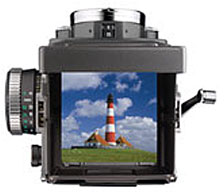 A TLR camera, held at waist level,
never stares the subject in the eye. People tend to go on looking and
acting naturally instead of posing for the camera - grown-ups as well
as small children and even animals. With this type of viewfinder, you
can also hold the camera very low or even place it on the ground when
the shot requires that. And you don't have to lie flat on your belly
yourself, or in "spycam" mode, even shoot around corners or in
"periscope" mode without revealing yourself. Because you look down into
the ground glass hood, you can stand facing one direction with the
camera pointing elsewhere - great for candid work!
A TLR camera, held at waist level,
never stares the subject in the eye. People tend to go on looking and
acting naturally instead of posing for the camera - grown-ups as well
as small children and even animals. With this type of viewfinder, you
can also hold the camera very low or even place it on the ground when
the shot requires that. And you don't have to lie flat on your belly
yourself, or in "spycam" mode, even shoot around corners or in
"periscope" mode without revealing yourself. Because you look down into
the ground glass hood, you can stand facing one direction with the
camera pointing elsewhere - great for candid work!
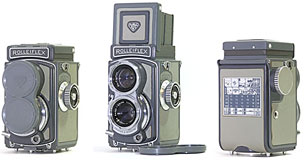 I like
square-formatted compositions anyway. It's what I grew up with. My
first camera used 127
roll film (a 1-5/8" x 1-5/8" or 4cm x 4cm square negative format),
as did the ubiquitous Kodak Instamatic 100
series snapshot cameras of my youth in the 1960s that used 126 size drop-in film
cartridges. (BTW, there were a few professional grade 127 cameras,
including the Baby
Rolleiflex).
I like
square-formatted compositions anyway. It's what I grew up with. My
first camera used 127
roll film (a 1-5/8" x 1-5/8" or 4cm x 4cm square negative format),
as did the ubiquitous Kodak Instamatic 100
series snapshot cameras of my youth in the 1960s that used 126 size drop-in film
cartridges. (BTW, there were a few professional grade 127 cameras,
including the Baby
Rolleiflex).
Back from the Brink
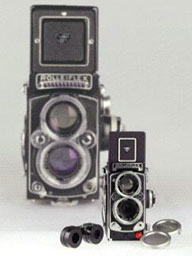 Just when I had sadly resigned
myself to the TLR being a relic of a bygone age, the concept got
rescued, sort of, by the ascendancy of digital photography. Back in
2006, Rollei's US distributor (Rollei is still very much in business
making both high-end professional SLRs, film and digital, as well as
consumer point and shoot cameras, and yes, they will even sell you a
real TLR Rolleiflex 2.8 or 4.0 wide-angle) Direct Source Marketing released a new
twin-lens reflex camera built by Komamura Corporation (originally
introduced in Japan in 2004) that was the spitting image of the Classic
Rolleiflex, with two lenses, one above the other. a hand crank lever, a
hooded viewfinder, a bright metal accented coal-black casing, and the
Rolleiflex logo. What was different is that the Rollei MiniDigi was
much smaller and digital, retaining the look and feel of the original,
but fitting in the palm of your hand or pocket.
Just when I had sadly resigned
myself to the TLR being a relic of a bygone age, the concept got
rescued, sort of, by the ascendancy of digital photography. Back in
2006, Rollei's US distributor (Rollei is still very much in business
making both high-end professional SLRs, film and digital, as well as
consumer point and shoot cameras, and yes, they will even sell you a
real TLR Rolleiflex 2.8 or 4.0 wide-angle) Direct Source Marketing released a new
twin-lens reflex camera built by Komamura Corporation (originally
introduced in Japan in 2004) that was the spitting image of the Classic
Rolleiflex, with two lenses, one above the other. a hand crank lever, a
hooded viewfinder, a bright metal accented coal-black casing, and the
Rolleiflex logo. What was different is that the Rollei MiniDigi was
much smaller and digital, retaining the look and feel of the original,
but fitting in the palm of your hand or pocket.
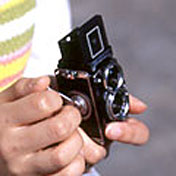 The hand crank is functional, but instead of
advancing film (which it doesn't use), the Rollei MiniDigi's crank
prepares the camera for the next shot. The classic popup hood and
viewfinder also provided the original's "Sportsfinder" function for
quick framing of action shots, However, the viewfinder screen used a
color LCD instead of the original ground glass, and the image is not
reversed, which would eliminate one of the major objections to TLRs
from amateurs.
The hand crank is functional, but instead of
advancing film (which it doesn't use), the Rollei MiniDigi's crank
prepares the camera for the next shot. The classic popup hood and
viewfinder also provided the original's "Sportsfinder" function for
quick framing of action shots, However, the viewfinder screen used a
color LCD instead of the original ground glass, and the image is not
reversed, which would eliminate one of the major objections to TLRs
from amateurs.
And happily, the Rolleiflex MiniDigi maintained a square picture format just like the film Rollei TLRs do. The square format means no shutter opportunities or valuable seconds are lost choosing between horizontal or vertical composition. Just look down into the viewfinder at waist level, aim, and shoot.
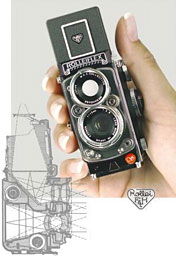 Very cool, but there were some
disappointing aspects as well. While the MiniDigi incorporated digital
camera technology, including SD memory cards, white balance, and fast
shutter speeds, but had a very pedestrian (even by 2004/2006 standards)
3-megapixel sensor offering only modest resolutions of 1760 x 1760,
1280 x 1280, or 640 x 640 pixels, and the manufacturer conceded that it
was really more of a toy and conversation piece or collector's item and
not really intended to be a full-featured digital camera.
Very cool, but there were some
disappointing aspects as well. While the MiniDigi incorporated digital
camera technology, including SD memory cards, white balance, and fast
shutter speeds, but had a very pedestrian (even by 2004/2006 standards)
3-megapixel sensor offering only modest resolutions of 1760 x 1760,
1280 x 1280, or 640 x 640 pixels, and the manufacturer conceded that it
was really more of a toy and conversation piece or collector's item and
not really intended to be a full-featured digital camera.
Megapixels are not the only factor in rendering high digital image quality: The lens is probably of greater practical importance. The MiniDigi had a five element lens, but it was fixed-focus, which definitely didn't speak "serious camera", even at the hefty $350 price. Nevertheless, it quickly sold out.
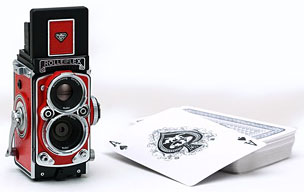 Fast
forward to 2008. Last week Direct Source Marketing announced the
upgraded MiniDigi AF 5.0, which now comes in red as well as the
traditional black.
Fast
forward to 2008. Last week Direct Source Marketing announced the
upgraded MiniDigi AF 5.0, which now comes in red as well as the
traditional black.
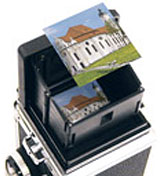 The new MiniDigi AF (auto focus) 5.0
incorporates some significant performance upgrades, including a
5 MP image file from a 3 MP CMOS sensor; autofocus (between
10cm/4" and infinity); and a 1.1" TFT display (up from the previous
0.9" unit), which allows you to preview and review images on a very
clear monitor located at the top of the camera (as it is on the
full-sized Rolleiflex TLR).
The new MiniDigi AF (auto focus) 5.0
incorporates some significant performance upgrades, including a
5 MP image file from a 3 MP CMOS sensor; autofocus (between
10cm/4" and infinity); and a 1.1" TFT display (up from the previous
0.9" unit), which allows you to preview and review images on a very
clear monitor located at the top of the camera (as it is on the
full-sized Rolleiflex TLR).
MiniDigi AF 5.0 will be available through specialty retailers. Pricing is expected to be $399 MSRP.
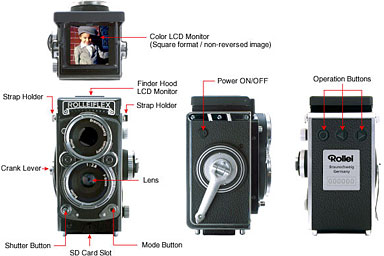 Besides
the features unique to Rolleiflex, the MiniDigi incorporates digital
camera technology - Mini SD memory cards w/SD card adapter, white
balance, fast shutter speeds, 5 MP sensor (which is still modest
by current standards, but should be adequate for general photography,
LCD monitor, etc., and as noted is also available in a
limited-production "Italian Red" version as well as the original
black.
Besides
the features unique to Rolleiflex, the MiniDigi incorporates digital
camera technology - Mini SD memory cards w/SD card adapter, white
balance, fast shutter speeds, 5 MP sensor (which is still modest
by current standards, but should be adequate for general photography,
LCD monitor, etc., and as noted is also available in a
limited-production "Italian Red" version as well as the original
black.
Personally, I still prefer the classic black & chrome.
So, is the MiniDigi AF 5.0 now a serious camera? Well, it's more serious than the original model, but no, not really. Still, I sure would love to have one!
For more details on the Mini Digi AF 5.0, see last week's press release. For more information, lore, and discussion about twin-lens reflex cameras, visit RolleiCafe.com.
Join us on Facebook, follow us on Twitter or Google+, or subscribe to our RSS news feed
Charles Moore has been a freelance journalist since 1987 and began writing for Mac websites in May 1998. His The Road Warrior column was a regular feature on MacOpinion, he is news editor at Applelinks.com and a columnist at MacPrices.net. If you find his articles helpful, please consider making a donation to his tip jar.
Links for the Day
- Mac of the Day: Digital Audio Power Mac G4, introduced 2001.01.09. 466-733 MHz processors, 133 MHz system bus, 4 PCI slots, first SuperDrive.
- Support Low End Mac
Recent Content
About LEM Support Usage Privacy Contact
Follow Low End Mac on Twitter
Join Low End Mac on Facebook
Favorite Sites
MacSurfer
Cult of Mac
Shrine of Apple
MacInTouch
MyAppleMenu
InfoMac
The Mac Observer
Accelerate Your Mac
RetroMacCast
The Vintage Mac Museum
Deal Brothers
DealMac
Mac2Sell
Mac Driver Museum
JAG's House
System 6 Heaven
System 7 Today
the pickle's Low-End Mac FAQ
Affiliates
Amazon.com
The iTunes Store
PC Connection Express
Macgo Blu-ray Player
Parallels Desktop for Mac
eBay

